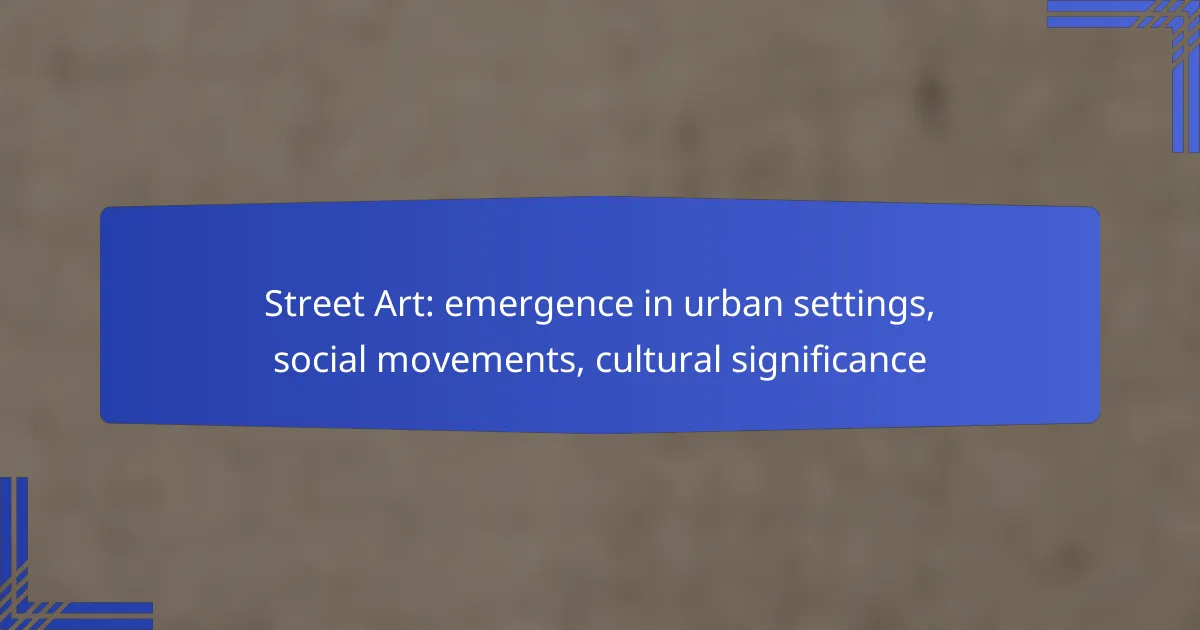Street art has emerged as a dynamic form of expression in urban settings, transforming neglected spaces into vibrant canvases that reflect social issues and cultural movements. This art form not only engages communities but also serves as a powerful medium for activism, highlighting critical issues such as racial equality, environmental protection, and gender rights. Through its visual impact, street art fosters a sense of identity and belonging while shaping the cultural landscape of cities.

How has street art emerged in urban settings in the UK?
Street art in the UK has emerged as a vibrant form of expression within urban environments, often reflecting social issues and cultural movements. It has transformed neglected spaces into canvases for creativity, allowing artists to engage with communities and provoke thought.
Influence of urban decay
Urban decay has played a significant role in the rise of street art in the UK. As cities faced economic decline and neglect, abandoned buildings and derelict spaces became the backdrop for artists seeking to reclaim and beautify their surroundings. This transformation often highlights the contrast between vibrant art and the starkness of decay.
Artists utilize these neglected areas to draw attention to social issues, such as poverty and inequality, effectively turning urban decay into a canvas for dialogue. For example, in cities like Bristol and London, murals on crumbling walls serve as powerful statements about the communities they inhabit.
Rise of graffiti culture
The rise of graffiti culture in the UK has been pivotal in shaping the street art scene. Originating in the late 20th century, graffiti began as a form of rebellion and self-expression among youth, often associated with specific subcultures. Over time, it evolved into a recognized art form, with artists like Banksy gaining international acclaim.
Graffiti culture has fostered a sense of identity and belonging among urban communities. Events such as graffiti festivals and competitions encourage local artists to showcase their work, further embedding street art into the cultural fabric of cities.
Community engagement initiatives
Community engagement initiatives have become essential in promoting street art as a tool for social change. Local councils and organizations often collaborate with artists to create murals that reflect the history and values of neighborhoods. These projects not only beautify public spaces but also foster community pride and involvement.
For instance, initiatives like the “Wall to Wall” project in London invite residents to participate in the creation of public art, ensuring that the artwork resonates with the local community. Such collaborations can lead to long-lasting relationships between artists and residents, enhancing the cultural significance of street art in urban settings.

What social movements are represented in street art?
Street art often reflects various social movements, serving as a powerful medium for expression and activism. It highlights issues such as racial equality, environmental protection, and gender rights, making art a voice for marginalized communities.
Black Lives Matter murals
Black Lives Matter murals have emerged as a prominent form of street art, symbolizing the fight against systemic racism and police brutality. These murals often feature bold colors and powerful imagery, aiming to raise awareness and foster dialogue around racial injustice.
Many cities, particularly in the United States, have designated spaces for these murals, allowing artists to express solidarity and community support. Notable examples include the large mural painted on 16th Street in Washington, D.C., which has become a site for protests and gatherings.
Environmental activism in street art
Environmental activism is increasingly represented in street art, with artists using their work to address climate change and promote sustainability. Murals often depict nature, endangered species, or the impacts of pollution, aiming to inspire action and awareness.
For instance, artists may create pieces that visualize the effects of plastic waste on marine life or highlight the importance of renewable energy. This form of art not only beautifies urban spaces but also serves as a call to action for individuals and communities to adopt eco-friendly practices.
Feminist themes in urban art
Feminist themes in urban art focus on gender equality, women’s rights, and the empowerment of marginalized genders. Street artists often challenge stereotypes and societal norms through provocative imagery and messages that advocate for change.
Murals may portray influential women, address issues like body positivity, or critique gender-based violence. Cities around the world, from New York to Berlin, feature such works, making feminist street art a vital part of the cultural landscape and a tool for social commentary.
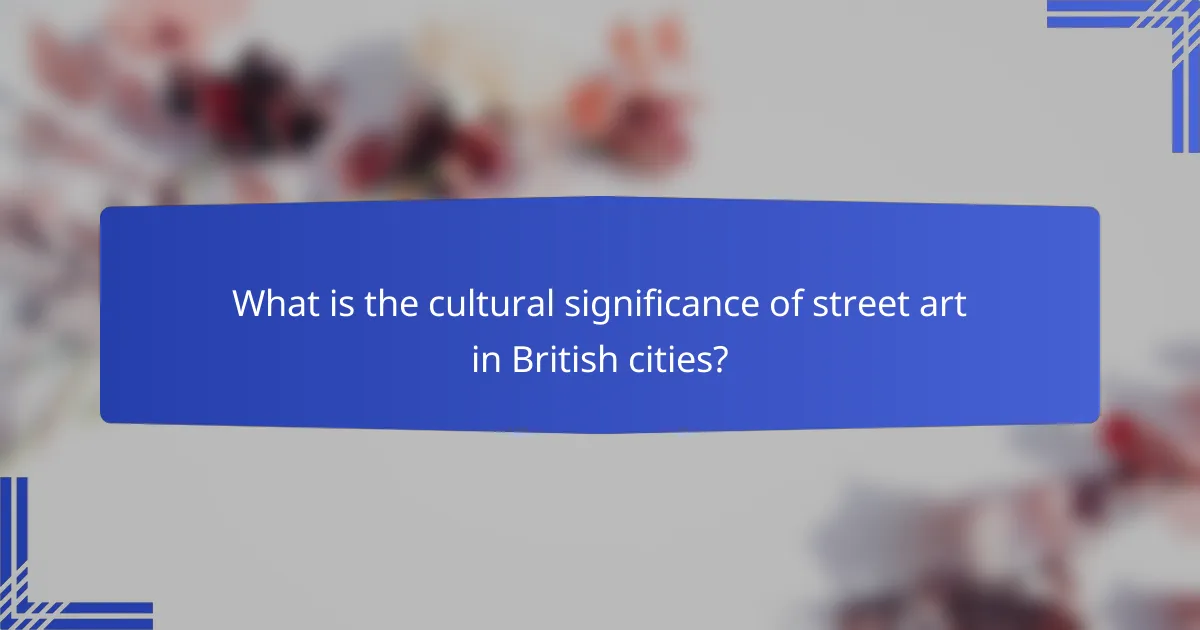
What is the cultural significance of street art in British cities?
Street art in British cities serves as a powerful medium for cultural expression, reflecting local identities and social movements. It plays a crucial role in shaping urban landscapes and fostering community engagement.
Expression of local identity
Street art often embodies the unique characteristics and narratives of local communities in British cities. Artists use murals and graffiti to convey messages that resonate with residents, celebrating cultural heritage and addressing social issues.
This form of art can transform neglected spaces into vibrant canvases, fostering a sense of pride and belonging among locals. For example, in areas like Bristol, street art has become synonymous with the city’s identity, attracting attention and sparking conversations about its history and culture.
Tourism and economic impact
Street art significantly contributes to tourism in British cities, drawing visitors eager to explore vibrant neighborhoods. Iconic works can become landmarks, enhancing the local economy through increased foot traffic to nearby businesses.
In cities like London, street art tours have emerged, providing guided experiences that highlight famous pieces and their creators. This not only boosts tourism but also supports local artists and promotes cultural exchange.
Street art festivals in London
London hosts several street art festivals that celebrate this dynamic art form, bringing together artists and enthusiasts from around the world. Events like the London Mural Festival showcase large-scale murals and offer workshops, fostering community involvement and artistic collaboration.
These festivals not only enhance the city’s cultural landscape but also provide opportunities for emerging artists to gain visibility. They often feature live painting sessions, allowing attendees to witness the creative process firsthand and engage with the art community.

How does street art influence social change?
Street art serves as a powerful medium for social change by visually communicating messages that resonate with the public. It often highlights social issues, challenges authority, and fosters community dialogue, making it an effective tool for activism.
Raising awareness through visual storytelling
Street art raises awareness by using visual storytelling to convey complex social issues in an accessible manner. Murals and graffiti can depict narratives that reflect community struggles, injustices, or cultural heritage, drawing attention to topics that may otherwise be overlooked.
For instance, a mural addressing climate change can illustrate the impact of environmental degradation on local communities, prompting viewers to engage with the issue. This form of storytelling can be particularly effective in urban areas where traditional media may not reach all demographics.
Engagement with marginalized communities
Street art often engages marginalized communities by providing them a platform to express their voices and experiences. Artists frequently collaborate with local residents to create works that reflect their realities, fostering a sense of ownership and pride.
Community-driven projects can empower individuals by highlighting their stories and struggles, encouraging dialogue among diverse groups. For example, a community mural project in a low-income neighborhood can unite residents around shared themes, promoting solidarity and collective action.
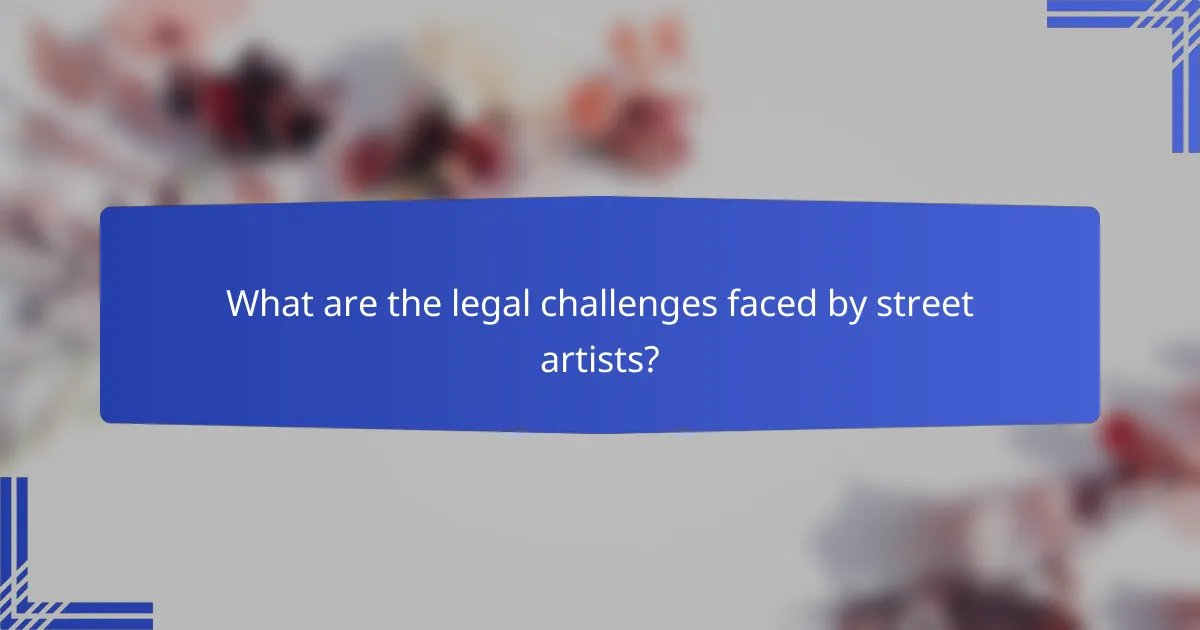
What are the legal challenges faced by street artists?
Street artists encounter various legal challenges, primarily revolving around issues of property rights and local regulations. These challenges can significantly impact their ability to create and display their work in urban environments.
Vandalism laws in the UK
In the UK, street art often falls under vandalism laws, which can lead to criminal charges if the artwork is deemed to deface property without permission. Local councils have the authority to remove unauthorized art, and penalties can include fines or community service. Artists should be aware that even if their work is well-received, it may still be classified as vandalism if not legally sanctioned.
Some cities have begun to embrace street art, creating designated areas where artists can legally paint. However, these initiatives vary widely, and artists must research local regulations to avoid legal repercussions.
Copyright issues with public art
Copyright issues arise when street artists create works in public spaces, as ownership of the artwork can be contested. Artists may retain copyright over their creations, but once the work is on someone else’s property, disputes can occur regarding reproduction and commercial use. It is crucial for artists to understand their rights and consider agreements with property owners.
Additionally, the use of copyrighted materials in street art can lead to infringement claims. Artists should ensure that their work does not violate existing copyrights to avoid potential legal challenges. Seeking legal advice or using original concepts can help mitigate these risks.
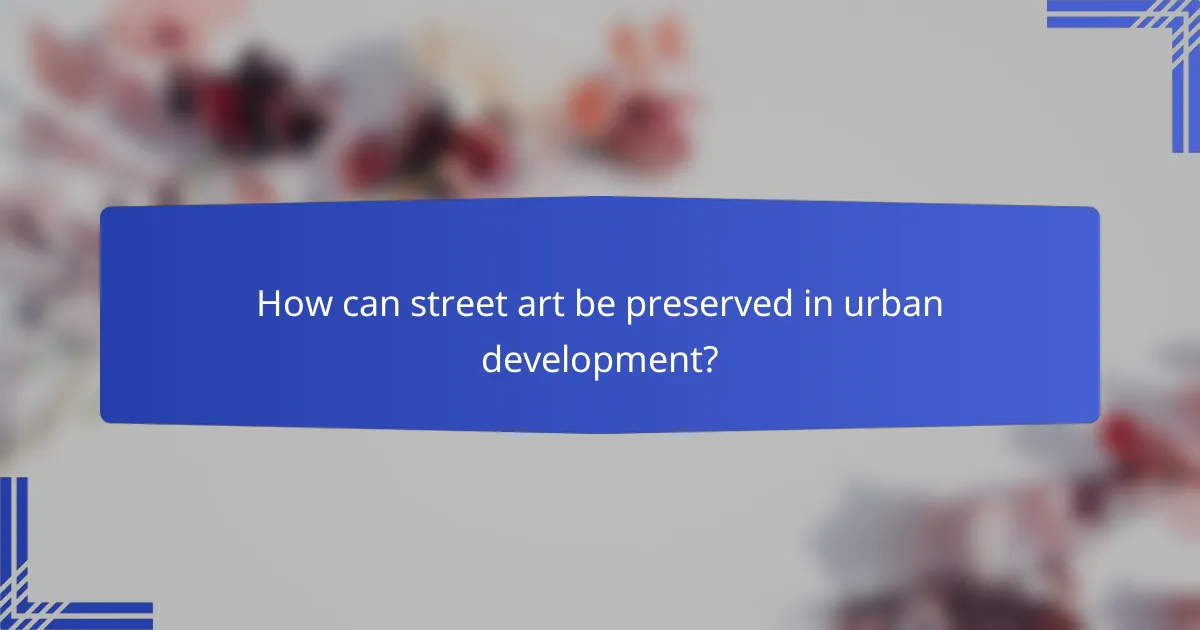
How can street art be preserved in urban development?
Preserving street art during urban development involves recognizing its cultural significance and integrating it into planning processes. Effective preservation strategies can maintain the artistic value while accommodating urban growth.
Community-led preservation efforts
Community involvement is crucial for preserving street art, as local residents often have a deep connection to the artwork. Initiatives like mural festivals or local art committees can mobilize support and resources to protect significant pieces.
Engaging artists and residents in discussions about which artworks to preserve fosters a sense of ownership and pride. This collaborative approach can lead to the creation of community archives or digital platforms that document and celebrate local street art.
Integration into urban planning
Urban planners can incorporate street art into development projects by designating specific areas for murals or installations. This not only enhances the aesthetic appeal of new developments but also promotes cultural tourism.
Considerations should include zoning regulations that allow for public art spaces and ensuring that new constructions do not obscure existing artworks. Collaborating with artists during the planning phase can lead to innovative designs that complement the urban landscape.
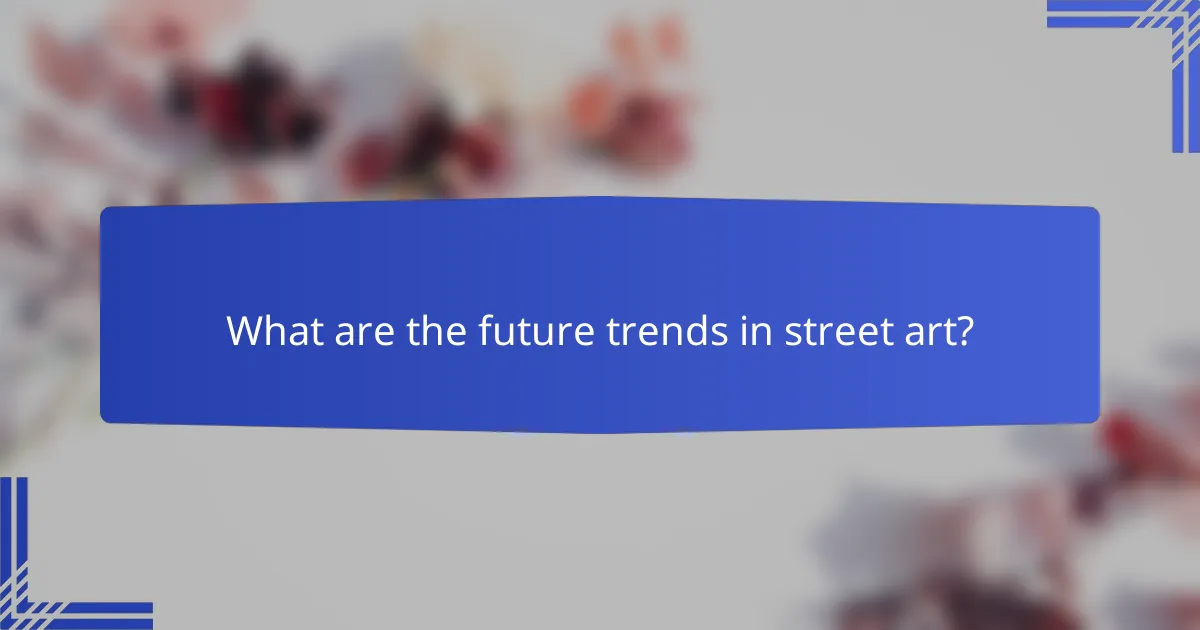
What are the future trends in street art?
Future trends in street art are increasingly leaning towards digital integration and community engagement. Artists are exploring new technologies and platforms, which enhance the visibility and impact of their work in urban settings.
Digital and augmented reality integration
Digital and augmented reality (AR) integration in street art allows artists to create interactive experiences that engage viewers in novel ways. By using smartphones or AR glasses, audiences can see additional layers of content overlaid on physical artworks, transforming traditional murals into dynamic narratives.
For example, some artists have developed apps that provide historical context or animations when a viewer scans a mural. This not only enriches the viewer’s experience but also encourages social sharing, expanding the reach of the artwork beyond its physical location.
When considering digital integration, artists should focus on user accessibility and ease of interaction. Ensuring that the technology is intuitive can enhance engagement and avoid alienating potential viewers. Additionally, collaborating with tech developers can help create more polished and impactful experiences.
